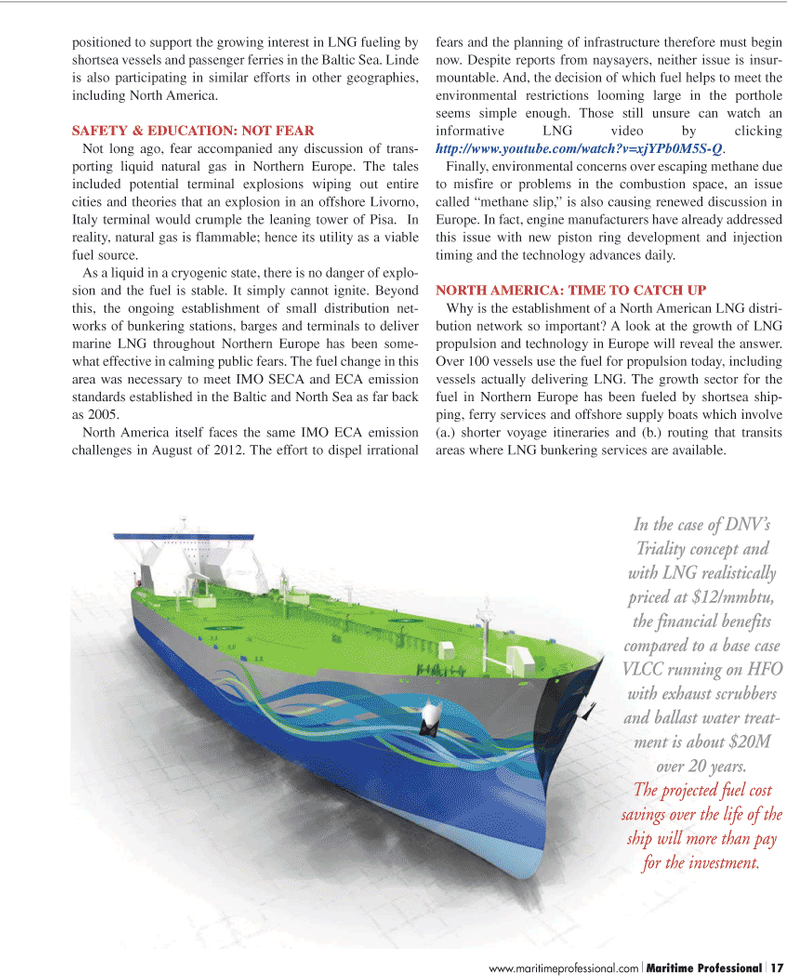
Page 17: of Maritime Logistics Professional Magazine (Q2 2011)
Energy Transportation
Read this page in Pdf, Flash or Html5 edition of Q2 2011 Maritime Logistics Professional Magazine
positioned to support the growing interest in LNG fueling by shortsea vessels and passenger ferries in the Baltic Sea. Linde is also participating in similar efforts in other geographies, including North America.
SAFETY & EDUCATION: NOT FEAR
Not long ago, fear accompanied any discussion of trans- porting liquid natural gas in Northern Europe. The tales included potential terminal explosions wiping out entire cities and theories that an explosion in an offshore Livorno,
Italy terminal would crumple the leaning tower of Pisa. In reality, natural gas is flammable; hence its utility as a viable fuel source.
As a liquid in a cryogenic state, there is no danger of explo- sion and the fuel is stable. It simply cannot ignite. Beyond this, the ongoing establishment of small distribution net- works of bunkering stations, barges and terminals to deliver marine LNG throughout Northern Europe has been some- what effective in calming public fears. The fuel change in this area was necessary to meet IMO SECA and ECA emission standards established in the Baltic and North Sea as far back as 2005.
North America itself faces the same IMO ECA emission challenges in August of 2012. The effort to dispel irrational fears and the planning of infrastructure therefore must begin now. Despite reports from naysayers, neither issue is insur- mountable. And, the decision of which fuel helps to meet the environmental restrictions looming large in the porthole seems simple enough. Those still unsure can watch an informative LNG video by clicking http://www.youtube.com/watch?v=xjYPb0M5S-Q.
Finally, environmental concerns over escaping methane due to misfire or problems in the combustion space, an issue called “methane slip,” is also causing renewed discussion in
Europe. In fact, engine manufacturers have already addressed this issue with new piston ring development and injection timing and the technology advances daily.
NORTH AMERICA: TIME TO CATCH UP
Why is the establishment of a North American LNG distri- bution network so important? A look at the growth of LNG propulsion and technology in Europe will reveal the answer.
Over 100 vessels use the fuel for propulsion today, including vessels actually delivering LNG. The growth sector for the fuel in Northern Europe has been fueled by shortsea ship- ping, ferry services and offshore supply boats which involve (a.) shorter voyage itineraries and (b.) routing that transits areas where LNG bunkering services are available.
In the case of DNV’s
Triality concept and with LNG realistically priced at $12/mmbtu, the financial benefits compared to a base case
VLCC running on HFO with exhaust scrubbers and ballast water treat- ment is about $20M over 20 years.
The projected fuel cost savings over the life of the ship will more than pay for the investment. www.maritimeprofessional.com Maritime Professional 17

 16
16

 18
18
